Delve into 10 Unusual Cosmic Objects challenging our understanding of space! Buckle up for a cosmic journey
Namaste, space enthusiasts! Our universe, with its boundless expanse, never fails to surprise
us. While we’ve learned a great deal about planets, stars, and galaxies, there are still many cosmic objects that defy easy explanation.

These celestial oddities push the boundaries of our current knowledge, challenging established theories and sparking intense scientific debate. Today, we'll take a dekko at ten such unusual objects that continue to baffle astronomers and physicists alike.
Buckle up, as we are about to embark on journey through the cosmos that highlights areas where our understanding is, well incomplete.
The Boomerang Nebula: coldest place in the universe
First up, we have the 'Boomerang Nebula'. Named for its distinctive shape, this nebula is actually the coldest known place in the universe. Its temperature dips to a bone-chilling -272 degrees Celsius, which is just a single degree above absolute zero!

Scientists believe this extreme coldness is due to the rapid expansion of gases ejected from a dying star at its center. However, the precise mechanisms driving this hyper-expansion remain a topic of active research and modeling.
Rogue Planets' - Mysterious wanderers in space
Next in line is 'Rogue Planets'. Unlike planets in our solar system, these wander through space without orbiting a star. Finding them is a tough nut to crack, since its difficult to 'see' them without the light of a parent star.

How these celestial wanderers form, and how common they are in our galaxy, are questions that keep astronomers busy and intrigued. Some theories suggest they might be ejected from planetary systems, while others propose they form independently in a similar way to regular stars.
Mysterious Fast Radio Bursts from space puzzle scientists
Our third cosmic enigma is 'Fast Radio Bursts (FRBs)'. These brief, yet incredibly powerful radio waves, emanate from the depths of space. Many last mere milliseconds, but they can release as much energy as the Sun emits in several days!

The sources of FRBs are still largely shrouded in mystery, with theories ranging from highly magnetized neutron stars (magnetars) to more exotic possibilities like – wait for it, get ready – theoretical alien technology.
Scientists are working hard to trace these bursts back to their origins, hoping to unlock the secrets hidden within their signals.
Scientists study invisible dark matter in space
The fourth mind-boggler is 'Dark Matter'. This is matter that we can't see directly because it does not interact with light. However, we know its there, because of its gravitational effects on things we can see like galaxies. The problem is, we do not know what it's made of.

Scientists are using a range of techniques, from underground detectors to particle accelerators to try and identify the dark matter particles that permeate that vastness of space.
Fifth we have 'Dark Energy'. If dark matter is weird, wait uil you understand dark energy
It's even weirder! Dark matter slows down expansion. Dark energy is a mysterious force that seems to be causing the universe to expand at an accelerating rate. Scientists have used observations of distant supernovas to map this expansion, which points to the existence of energy throughout space.

Its true nature is a big puzzle in cosmology today.
Supervoids: vast empty regions challenge universe models
Sixth on our list is 'Supervoids'. In contrast to the clustering of galaxies, supervoids are vast regions of space that are extremely devoid of galaxies and matter. These empty patches can span hundreds of millions of light-years.

The formation and evolution of supervoids are not yet fully understood, and they challenge our models of how the universe’s structure comes to be, suggesting the universe is unevenly shaped.
Challenging concepts simplified for easy understanding
The following points cover concepts that would require extra effort for the everyday person to easily understand. The language should be simplified as much as possible. Also, let it be in terms of 3 short sentences for each topic.

Neutron star collisions create kilonovae with heavy elements
Seventh: 'Kilonovae' are explosions that happen when two neutronstars smash into each other. This event creates gravity waves and releases a lot of heavy materials, like gold and platinum. Studying Kilonovae helps us comprehend heavy element formation in the universe.
Quasars: Bright galactic nuclei powered by black holes, offering insights on early universe
Eighth: 'Quasars' are extremely bright, active galactic nuclei. They're powered by supermassive black holes gobbling up matter. Quasars provide views into the early universe and galaxy evolution.

Neutron stars with strong magnetic fields reveal physics in intense conditions
Ninth: 'Magnetars' are neutrons stars with incredibly strong magnetic fields. These fields can lead to energetic bursts and exotic phenomena. They help us learn more about physics in intense conditions.
Mysterious ultra-bright X-ray sources in space
Tenth: 'Ultra-Luminous X-ray Sources (ULXs)' are off-nuclear X-ray that are super bright. They are still not fully understood. They may involve black holes or neutron stars accreting matter in unusual ways.











